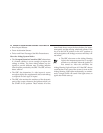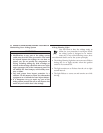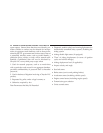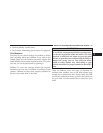
inflating side curtain airbag pushes the outside edge of
the headliner out of the way and covers the window.
The airbag inflates in about 30 milliseconds (about
one-quarter of the time that it takes to blink your eyes)
with enough force to injure you if you are not belted
and seated properly, or if items are positioned in the
area where the side curtain airbag inflates. This espe-
cially applies to children. The side curtain airbag is
only about 3-1/2 in (9 cm) thick when it is inflated.
If a Deployment Occurs
The airbag system is designed to deploy when the ORC
detects a moderate-to-severe collision to help restrain the
driver and front passenger and then to immediately
deflate.
NOTE: A frontal collision that is not severe enough to
need airbag protection will not activate the system. This
does not mean something is wrong with the airbag
system.
If you do have a collision that deploys the airbags, any or
all of the following may occur:
•
The nylon airbag material may sometimes cause abra-
sions and/or skin reddening to the driver and front
passenger as the airbags deploy and unfold. The
abrasions are similar to friction rope burns or those
you might get sliding along a carpet or gymnasium
floor. They are not caused by contact with chemicals.
They are not permanent and normally heal quickly.
However, if you haven’t healed significantly within a
few days or if you have any blistering, see your doctor
immediately.
•
As the airbags deflate, you may see some smoke-like
particles. The particles are a normal by-product of the
process that generates the non-toxic gas used for
airbag inflation. These airborne particles may irritate
the skin, eyes, nose, or throat. If you have skin or eye
irritation, rinse the area with cool water. For nose or
52 THINGS TO KNOW BEFORE STARTING YOUR VEHICLE


















